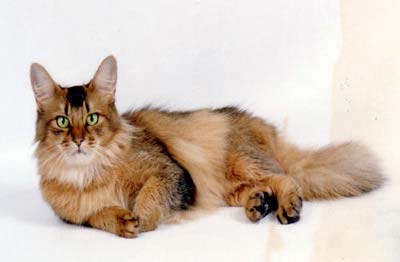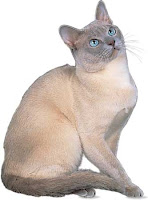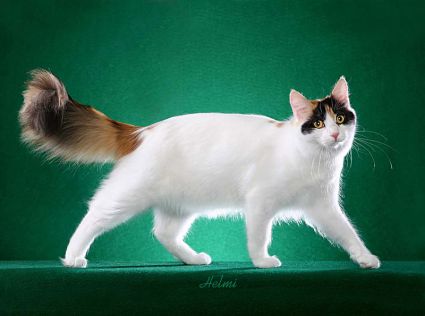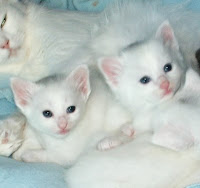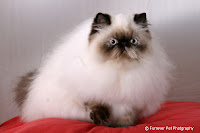Personality Cats - Turkish Van Cat Breeds
Turkish Van Cat Breeds - How to be seen on the bus to his fascination with water, the love for his other qualities race. (Vans are energetic, flexible and intelligent. I'm very healthy, gentle people to get along) is known owner of Van.
It can take months to work on, to keep up with them, but they are known for their van (action-packed) temperament. You are talkative, demanding attention and show enthusiasm for the dinner. Farmers say that the transporters for their devotion to their human companions, and sometimes, that transfer of a van for a family makes to another are known. Niche always one or two people in the house, usually those who are with them at first, and the band with them to have forever.
Cat Breed Traits
Turkish Van Cat Breeds - The Turkish Van is often confused with the Turkish Angora, but put them together and it is easy to see that they are totally different breeds. The Angora is smaller and thinner than the bus and not the (truck model) traditionally, a term borrowed from the Turkish Van for painting in particular used to describe the body color and white markings and black tail. The color should not occupy more than 20 percent of the entire body.
The model of the van is from the dominant white spotting gene factor pie (S), which they dominated with patches of white spots of color. This gene is difficult to control and allows the Vans Turkish race with the right color is difficult.
Some vehicles have a patch called color between the shoulder blades (Mark of Allah). Tabby M on his forehead as a gift to the Virgin Mary, it's personal identification number Allah) and good luck in Muslim countries.
History of the Turkish Van Cat Breed?
When the Ark on Mount Ararat arrived around 5,000 years ago, Noah has been a little busy to animals in their hurried flight from the will to have hit the continent. In the confusion, two cats, jumping a red and white swim in the water and on land. When the tide retreated, the cats in the Lake Van, about 75 miles (121 km) south of Mount Ararat, where they lived.
At least, that's a story about the origins of the Turkish Van, a natural breed that lived in region Lake Van in Turkey and in neighboring areas of Syria, Iran, Iraq and Russia, God knows how long. As (Swimming Cat) is known for his fascination with water is known. The most likely explanation for the benefit of swimming is at extreme temperatures in their region. Since summer temperatures reach well over 100? F (37.8 º C), cats have learned to swim to survive.
This may also explain the unique development of the (hydrophobic) of the coat. Most cats hate wet, perhaps because they spend hours reorganizing their fur. The Turkish Van, such as cashmere wool is water-resistant, so that the paint on children and dogs in the relatively dry season.
Whatever the reason for passion of the cats with water, do not, the Turkish Vans arrived in region Lake Van and whence they came. Christmas decorations comes from 5000 BC dogs is very much like the Turkish Van. If so, paint the right of the oldest existing breeds.
Vans were the first mention resource persons will introduced to Europe by soldiers returning from the Crusades bit "of the period 1095-1272 AD Over the centuries, the transporters from all the continents of the source of the invaders is carried out, traders and explorers Cat Europe, Turkish, Ringtail Cat, long-haired Russian. The cars were called by different names, since cats, vans, none of them are likely to react..
Modern history and best known of Van began in 1955 Lushington and Sonia Halliday British Laura gave two people the source of the young animals during the tour of Turkey. Because the race is unknown in England at that time decided to try working with her cats and for recognition of the Board of Directors of the Cat Fancy in Great Britain.
Gatehouse Lydia Russell was also in the spread of the breed in England and Europe and instrumental help get new players in Turkey breeder. At first it was slow. Designed for cats are many trips to Turkey, and the cats had to go through a long quarantine periods for England. Vans, but they were resource persons to breed true, and in 1969, the hard work has paid off Pls Turkish Van was the status of full GCCF pedigree given.
Kittens prior to their arrival in America in 1970, but it was only breeders Reark Barbara and Jack started the race in 1983 minivans that have begun to flourish in the United States. In 1985, the status of the Turkish TICA championship. The CFA accepted the breed for registration in 1988 and May 1993, the provisional status with the CFA.
Until recently the source of the transporter are officially recognized in Turkey, although very popular as a pet. Vans now available from the College of Agriculture with the Turkish Ankara Zoo, the coach also in Angora. Vans are not allowed to exported from the country, and most of our herd is now in Europe.
Copyright © 1998 by Barron's Educational Series, Inc. based on
ENCYCLOPEDIA OF CAT BREEDS by J. Anne Helgren.
